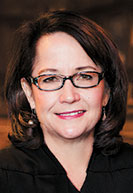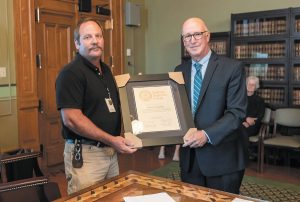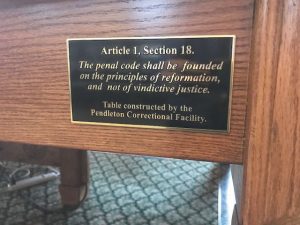Subscriber Benefit
As a subscriber you can listen to articles at work, in the car, or while you work out. Subscribe NowEvery table, desk, podium and memorial box that’s constructed at the Pendleton Correctional Facility’s furniture factory has its own unique set of challenges.
In this instance, when Vince Stanley, the Indiana Department of Correction’s physical plant director at the Pendleton facility, and a group of inmates started a project to build a new table for the Indiana Supreme Court’s conference room, they had to figure out how to make it functional for the court’s five justices while adding unique details.
That included putting the court’s distinctive seal in the middle of the table and engraving all the names of all 111 Indiana Supreme Court justices, equally spaced, around the edges of the 6-by-14-foot table.
Stanley acknowledged it was a challenge getting all 111 justice names to line up from end-to-end, spaced equally around the table. Also, he said the installation of the trim became time-consuming due to precision cutting, because the trim was built in separate pieces and not one full piece.

Stanley described it as being like thousands of pieces put together in a puzzle.
“We always try to mix up our design,” he said.
The table was delivered to the Supreme Court on July 14.
In late August, on a quiet day at the court, Chief Justice Loretta Rush showed off the table and pointed out a plaque attached to one its corners that features Article 1, Section 18 of the Indiana Constitution: “The penal code shall be founded on the principles of reformation, and not of vindictive justice.”
Rush noted the conference room table is where justices meet to decide cases, making it a place where history is literally made.
Humble beginnings
When Stanley started the furniture factory eight years ago, he said he got it off the ground with support from Pendleton’s warden.
For inmates who want to work at the furniture factory, it’s like any other job, Stanley said: When he has openings, they can interview for positions.
The Pendleton Correctional Facility opened the factory with seven inmates and one staff member making picture frames and specialty items. It has since grown to employ about 25 inmates and two staff members.

Stanley said the furniture factory is split into four areas. That includes a picnic table fabrication and assembly area, which he estimates has produced close to 5,000 picnic tables for the Indiana Department of Natural Resources, state parks, schools, towns and private businesses.
Also in the fabrication area, inmates build desks, podiums, conference tables, memorial boxes and plaques. Other customers have included various state law enforcement agencies, the governor’s and lieutenant governor’s offices, and the Office of the Attorney General.
Generally, Stanley said, he gets projects via word-of-mouth.
The DOC facility also made the desk used by Supreme Court Sheriff Joe Dowdell. Stanley said the Pendleton facility replicated the same desk that already sat outside the Supreme Court’s courtroom, so the court now has the same desks on each side of the courtroom’s entryway.
The table
Work on the court’s table began Aug. 26, 2022, and took 160 days, or 960 working hours, to build, Stanley said, with nine inmates working on the project.
Stanley worked with the court on designing the table, with Jerry Jones and Brad Patterson overseeing the table’s fabrication and the day-to-day operations.

According to Stanley, there was only one major issue with the table, and that involved rebuilding the drawer units a week before delivery. All the drawer pulls were made by the late Mike Keel, the Michigan City welding shop foreman who perfectly matched the original pulls.

Walnut, oak, cherry and maple wood make up the table’s inlay, with all the pieces being cut by hand, fitted and glued individually. Stanley said all the wood came from trees grown in Indiana.
The corners of the table’s legs were machined with a miter lock bit, Stanley said, which makes them structurally stronger.
“Projects like these will become part of history and we are all honored to be part of this,” he said.
Moving in
According to Dowdell, the Supreme Court sheriff, part of the court’s operations team coordinated with the DOC facility on the table. The court knew the DOC facility had created a table for the Governor’s Office, so it reached out to Stanley and the facility in 2022 to commission the construction of the new table, moving the old one into the adjoining robing room.
“The chief was very adamant about the table fitting the room,” Dowdell said.
Once it arrived, Dowdell said it took 12 people to get the table into the court’s conference room. The base is in one piece, and the movers had to carry it up three flights of stairs.
The entire table weighs in at more than 800 pounds, Dowdell noted. It features the court’s seal, placed squarely in the middle.
“We wanted something that couldn’t be removed,” he said.
Rush said some retired justices have returned to the conference room to see the new table. She also noted that the state’s Judicial Nominating Commission meets in the conference room and uses it.

“This table is used a lot,” she said.
‘Collaboration and redemption’
In August, the chief went to the DOC facility and thanked all the inmates that worked on the table.
“The men were very proud of the work,” she said, adding “I saw their pride in their craftsmanship,”
Rush also delivered a letter to the inmates thanking them for their work.
The letter described the conference table as not only an “astonishing, unique piece of furniture,” but also as “a symbol of collaboration and redemption.”
Rush also wrote, “And please know that this conference table will be a focal point for countless discussions and decisions as our Court — and other state leaders who use the space — strive to improve the lives of all Hoosiers.”•
Please enable JavaScript to view this content.
